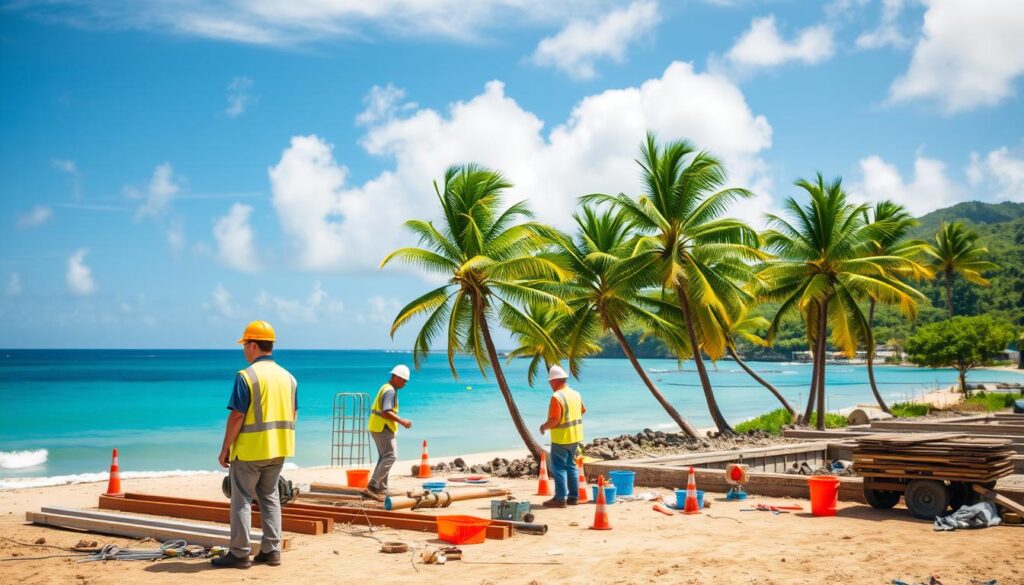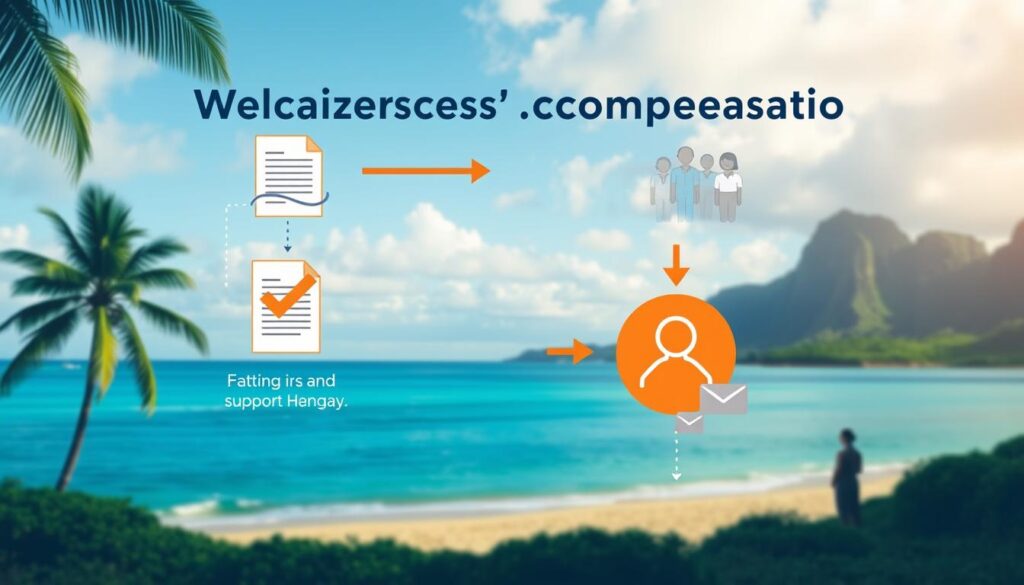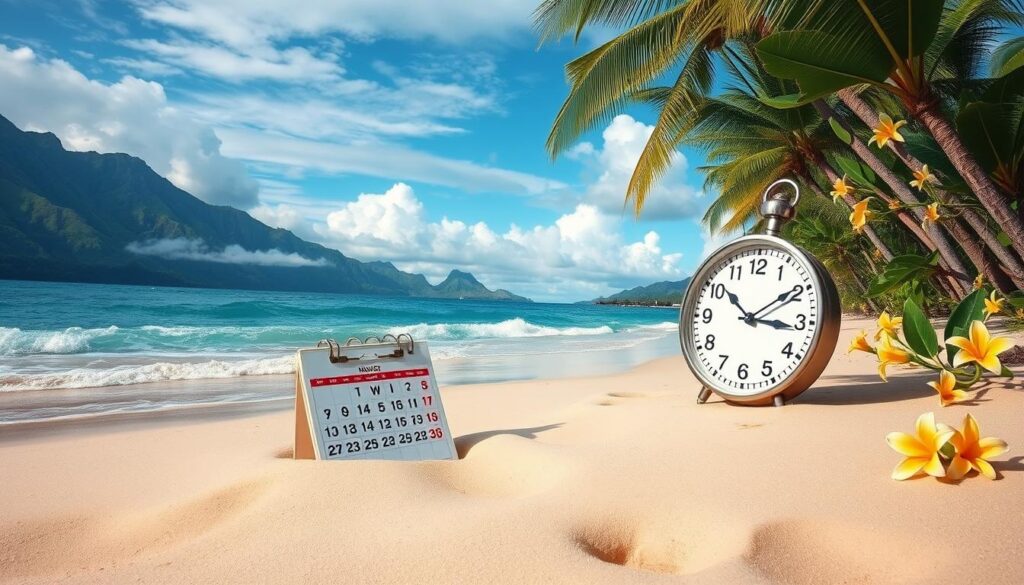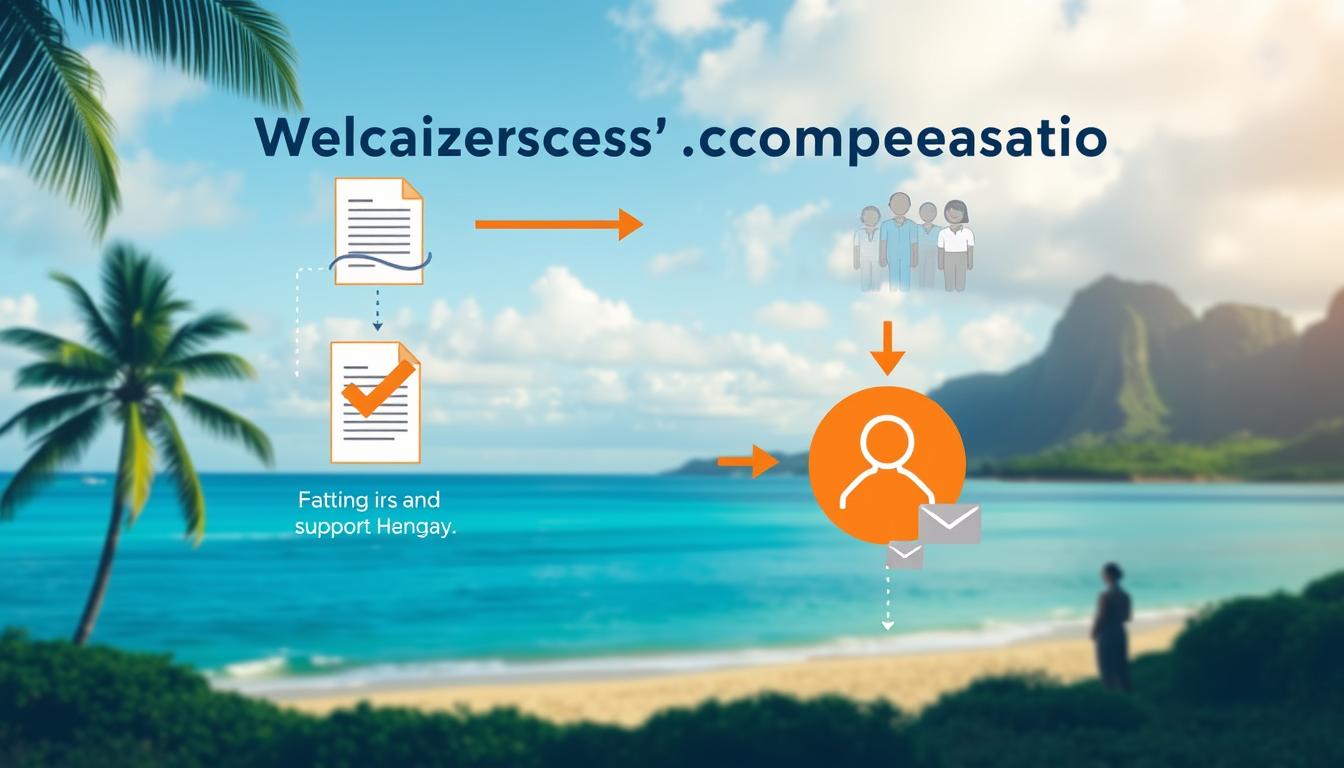If you work in Hawaii, knowing the workers compensation statute is key. It protects your rights and benefits if you get hurt or sick at work. This guide will help you understand Hawaii’s laws. You’ll learn how to get the benefits you deserve.
Hawaii’s laws aim to help both workers and employers. They provide a clear path for dealing with work-related injuries and illnesses. Knowing the basics, who’s covered, and how to file a claim can help you. It ensures you get the support you need after an accident or illness at work.

Key Takeaways
- Comprehensive overview of Hawaii’s workers compensation statute
- Understanding the eligibility criteria and coverage for employees
- Navigating the claims process and accessing available benefits
- Employer obligations and insurance requirements in Hawaii
- Dispute resolution and appeal procedures for injured workers
Understanding Hawaii’s Workers Compensation System
Hawaii’s workers compensation system started in the early 1900s. It was made to protect Hawaii labor laws. Over time, it has changed to meet the needs of workers and ensure safety and rights.
Historical Development of Workers Comp in Hawaii
In 1915, Hawaii passed the Hawaii Workmen’s Compensation Law. This law created a no-fault system. It gave injured workers medical care and money for lost wages, no matter who was at fault.
Since then, the law has been updated many times. These changes reflect Hawaii’s commitment to the labor market. Key updates include adding coverage for occupational diseases in the 1960s and stricter safety rules in the 1970s.
Key Principles and Objectives
The system in Hawaii follows several important principles:
- Providing quick and effective medical care to injured workers
- Ensuring fair and just compensation for lost wages
- Encouraging safe workplaces and preventing accidents
- Reducing the need for expensive and long legal battles
These goals aim to create a fair and efficient system. It supports both employers and employees, making work safer and more productive.
Regulatory Framework Overview
The system in Hawaii is guided by the Hawaii Revised Statutes, Title 12, Chapter 386, and administrative rules. This framework outlines the rights and duties of employers and employees. It also explains how to file claims, get benefits, and solve disputes.
The Department of Labor and Industrial Relations oversees the system. They enforce rules, investigate claims, and settle disputes. Employers must have insurance or self-insure. Not doing so can lead to big penalties and legal trouble.
| Key Aspects of Hawaii’s Workers Compensation System | Description |
|---|---|
| Covered Employees | All employees in the state, with limited exceptions |
| Insurance Requirements | Employers must carry workers compensation insurance or self-insure |
| Claim Filing Process | Injured workers must report incidents to their employer and file a claim |
| Dispute Resolution | Disputes are adjudicated through the Department of Labor and Industrial Relations |
Who Is Covered Under Hawaii Workers Compensation Laws
Hawaii’s workers compensation laws cover a wide range of workers. This ensures that those hurt on the job get the help and benefits they need. From full-time and part-time employees to seasonal workers, the state protects many types of workers.
It’s also important to know about exceptions and special cases. For example, domestic workers and agricultural employees might have different rules than regular employees. Knowing these details helps both employers and workers understand the workers compensation system better.
Covered Worker Categories
- Full-time employees
- Part-time employees
- Seasonal workers
Exceptions and Special Cases
- Domestic workers
- Agricultural employees
- Independent contractors (not covered under workers compensation laws)
Employers must follow Hawaii’s workers compensation laws to protect their workers. Knowing who is covered and the rules helps businesses keep their workplaces safe. This way, they can ensure their employees are well-protected.
| Worker Category | Eligibility | Exceptions |
|---|---|---|
| Full-time Employees | Fully Covered | None |
| Part-time Employees | Fully Covered | None |
| Seasonal Workers | Fully Covered | None |
| Domestic Workers | Covered if employed for 25+ hours per week | Exempt if employed for less than 25 hours per week |
| Agricultural Employees | Covered if employed for 100+ hours per month | Exempt if employed for less than 100 hours per month |
| Independent Contractors | Not Covered | Must be classified as an independent contractor, not an employee |
Required Insurance Coverage and Employer Obligations
Hawaii employers must follow the state’s workers’ compensation insurance rules. This ensures injured workers get the medical care and financial help they need. It helps them recover and get back to work.
Types of Insurance Coverage Available
Employers in Hawaii have two main choices for workers’ comp insurance:
- Private insurance: Buying a policy from a licensed carrier
- Self-insurance: Getting approval from the Department of Labor and Industrial Relations to handle their own insurance
Self-Insurance Requirements
Employers choosing self-insurance must show they can handle claims. They need to meet certain financial standards set by the state. This includes having enough money, a security deposit, and extra insurance.
Penalties for Non-Compliance
Not having the right workers’ comp insurance can lead to big penalties. Employers might face fines, stop-work orders, and even criminal charges. It’s crucial to follow the rules to avoid these issues and protect your business and workers.
“Ensuring adequate workers’ compensation coverage is a critical responsibility for Hawaii employers. Compliance with state laws protects both the business and its valued employees.”
Filing a Workers Compensation Claim in Hawaii
After a workplace injury, the claim process can seem overwhelming. But knowing the steps can make it easier. In Hawaii, injured workers must follow certain rules when filing a claim.
First, tell your employer about the injury right away. This should be within 30 days of the accident. This step starts the claim process and lets your employer start the paperwork and investigations.
- Give your employer a written notice about the injury. Include the date, time, and what happened.
- Collect any medical records or documents about your injury and treatment.
- Work with your employer to fill out the needed documentation requirements, like claim forms and witness statements.
It’s important to report and document your injury correctly and on time. This ensures you get workers compensation benefits in Hawaii. Knowing the rules helps you move through the process smoothly and focus on getting better.
| Claim Reporting Timeline | Documentation Needed |
|---|---|
| Report injury within 30 days | Claim forms, medical records, witness statements |
| File claim within 2 years of incident | Detailed account of incident, physician reports |
Getting help from a workers compensation attorney is also a good idea. They can make sure your claim process goes right and protect your rights during injury reporting and documentation requirements.

“The key to a successful workers compensation claim is timely and accurate injury reporting and documentation requirements.”
Hawaii Workers Compensation Statute: Benefits and Coverage
Hawaii’s workers compensation statute offers a wide range of benefits and coverage for injured workers. It covers everything from medical treatment to temporary and permanent disability payments. The goal is to support workers in their recovery and help them get back to work.
Medical Treatment Benefits
Employers in Hawaii must pay for medical costs related to work injuries and illnesses. This includes doctor visits, hospital stays, surgery, and rehabilitation. The aim is to help workers get the care they need and reduce their medical expenses.
Temporary Disability Benefits
Workers who can’t work due to injury or illness may get temporary wage replacement benefits. These benefits are a part of their regular wages while they’re out. The amount and how long they last depend on the injury’s severity and the worker’s earnings before the injury.
Permanent Disability Benefits
For injuries or illnesses that cause permanent harm, Hawaii offers long-term benefits. These rehabilitation services include vocational help, job placement, and ongoing medical care. They aim to support workers in their long-term recovery and return to work.
| Benefit Type | Description | Eligibility Criteria |
|---|---|---|
| Medical Treatment | Covers the cost of doctor visits, hospitalization, surgery, and rehabilitation services | Work-related injury or illness |
| Temporary Disability | Provides a portion of the worker’s regular wages while unable to work | Work-related injury or illness that causes temporary inability to perform job duties |
| Permanent Disability | Offers long-term support, including vocational rehabilitation and ongoing medical care | Work-related injury or illness resulting in permanent impairment |
Understanding Hawaii’s workers compensation statute helps injured workers navigate the system. They can access the support they need to recover and return to their jobs.
Time Limits and Deadlines for Claims
Understanding the deadlines for workers compensation claims in Hawaii is key. Knowing these rules helps protect your rights and ensures your claim is handled right.
The statute of limitations for filing a claim in Hawaii is usually one year after the injury or illness. But, there are some exceptions. So, it’s vital to act fast. Also, you must tell your employer about an injury within 30 days or your claim might be denied.
- Injury Reporting Timeframe: Employees must notify their employer of a work-related injury within 30 days of the incident.
- Statute of Limitations: Workers generally have one year from the date of injury or illness to file a workers compensation claim.
- Claim Deadlines: Certain benefits, such as temporary disability payments, have strict deadlines that must be met to receive full compensation.
Missing these notification requirements and claim deadlines can harm your claim. It’s important for workers to know these rules and act quickly. This way, they can protect their rights and get the benefits they deserve.
| Claim Requirement | Deadline |
|---|---|
| Injury Reporting | 30 days |
| Statute of Limitations | 1 year |
| Temporary Disability Benefits | Varies |
Knowing the time limits and deadlines for workers compensation claims in Hawaii is crucial. It helps workers protect their rights and get the benefits they are owed. By understanding these rules, workers can confidently navigate the system and increase their chances of a successful claim.

Rights and Responsibilities of Injured Workers
In Hawaii, injured workers have certain rights and duties. Knowing these is key for a smooth claims process.
Employee Notification Requirements
If you get hurt at work, tell your boss right away. You have 30 days to report it. Not telling them on time could hurt your claim.
Medical Examination Rights
You can choose your doctor for work injuries. But, your boss might ask you to see their doctor. You can get a second opinion if you don’t agree.
Return to Work Protocols
When you’re ready to go back to work, your boss must put you in your old job or a similar one. They must also make sure you can do your job safely.
Knowing your worker obligations helps you through Hawaii’s workers compensation system. It protects your rights and gets you the benefits you deserve.
| Notification Timeline | Medical Examination Rights | Return to Work Protocols |
|---|---|---|
| Notify employer within 30 days of injury/illness | Choose your own healthcare provider or accept employer’s selection | Employer must reinstate you to previous or suitable alternative position |
“Protecting the rights of injured workers is crucial in ensuring a fair and just workers compensation system.”
Dispute Resolution and Appeals Process
In Hawaii, workers’ compensation disputes can happen. Luckily, the state has a detailed system to solve these problems. It starts with trying to find a solution through mediation, where everyone tries to agree.
If mediation fails, a formal hearing is next. The Department of Labor and Industrial Relations holds these hearings. An impartial judge will look at the evidence and make a decision. This decision can be appealed, giving a chance to challenge the first ruling.
It’s key for everyone to know their rights during this process. Employees might need to give more information or go to medical exams. Employers and insurers must follow strict rules and talk clearly. By following these steps carefully, workers’ rights are protected, and employers stay in line with the law.
FAQ
What is the purpose of Hawaii’s workers compensation system?
Hawaii’s workers compensation system helps employees who get hurt on the job. It ensures they get medical care, money to live on, and support to get back to work.
Who is covered under Hawaii’s workers compensation laws?
Most employees in Hawaii are covered, like full-time and part-time workers. But, some like independent contractors and farm workers might not be.
What types of insurance coverage are required for employers in Hawaii?
Employers in Hawaii must have workers compensation insurance. They can get it from a private company or self-insure. The choice depends on the business size and type.
What benefits are available to injured workers in Hawaii?
Injured workers in Hawaii get many benefits. These include medical care, money for temporary disability, and help to find new jobs. The amount depends on the injury and the worker’s salary before getting hurt.
What is the process for filing a workers compensation claim in Hawaii?
To file a claim in Hawaii, workers must tell their employer within 30 days. The employer then starts the process. They work with the insurance company to make sure the worker gets the right benefits.
What are the time limits and deadlines for filing a workers compensation claim in Hawaii?
Hawaii has strict deadlines for claims. Workers must tell their employer within 30 days. They also have two years to file the claim after the injury or when they find out about the illness.
What rights and responsibilities do injured workers have in Hawaii?
Injured workers in Hawaii have rights like getting medical care and choosing a doctor. They also have the right to go back to their old job. Workers must follow doctor’s orders and help with the claims process.
How can workers compensation disputes be resolved in Hawaii?
Hawaii has a process for solving disputes. It starts with trying to solve things informally. If that doesn’t work, there are formal hearings and appeals.



